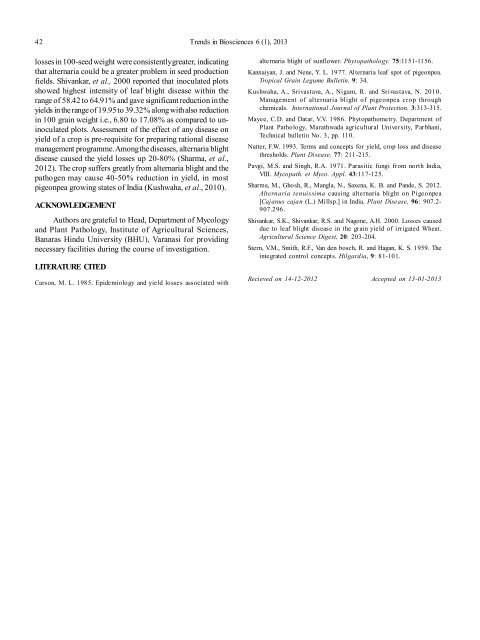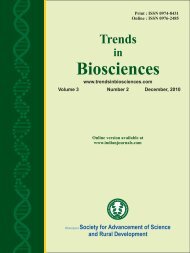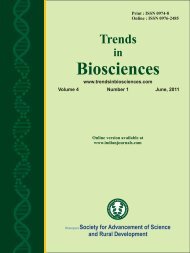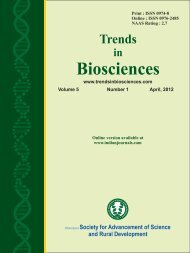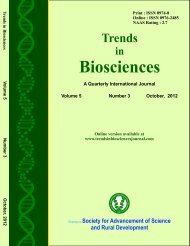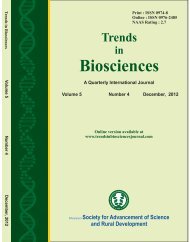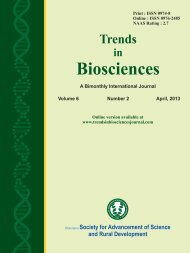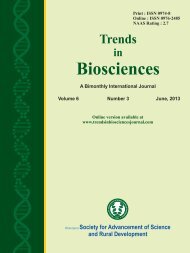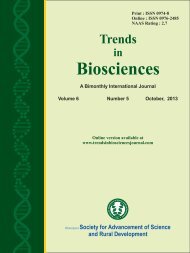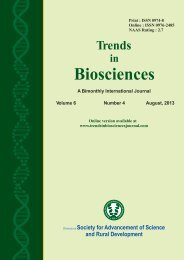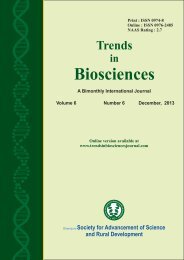TRENDS IN BIOSCIENCES 6-1, 2013 EDITION
CALL FOR RESEARCH PAPERS
CALL FOR RESEARCH PAPERS
Create successful ePaper yourself
Turn your PDF publications into a flip-book with our unique Google optimized e-Paper software.
42 Trends in Biosciences 6 (1), <strong>2013</strong><br />
losses in 100-seed weight were consistently greater, indicating<br />
that alternaria could be a greater problem in seed production<br />
fields. Shivankar, et al., 2000 reported that inoculated plots<br />
showed highest intensity of leaf blight disease within the<br />
range of 58.42 to 64.91% and gave significant reduction in the<br />
yields in the range of 19.95 to 39.32% along with also reduction<br />
in 100 grain weight i.e., 6.80 to 17.08% as compared to uninoculated<br />
plots. Assessment of the effect of any disease on<br />
yield of a crop is pre-requisite for preparing rational disease<br />
management programme. Among the diseases, alternaria blight<br />
disease caused the yield losses up 20-80% (Sharma, et al.,<br />
2012). The crop suffers greatly from alternaria blight and the<br />
pathogen may cause 40-50% reduction in yield, in most<br />
pigeonpea growing states of India (Kushwaha, et al., 2010).<br />
ACKNOWLEDGEMENT<br />
Authors are grateful to Head, Department of Mycology<br />
and Plant Pathology, Institute of Agricultural Sciences,<br />
Banaras Hindu University (BHU), Varanasi for providing<br />
necessary facilities during the course of investigation.<br />
LITERATURE CITED<br />
Carson, M. L. 1985. Epidemiology and yield losses associated with<br />
alternaria blight of sunflower. Phytopathology. 75:1151-1156.<br />
Kannaiyan, J. and Nene, Y. L. 1977. Alternaria leaf spot of pigeonpea.<br />
Tropical Grain Legume Bulletin. 9: 34.<br />
Kushwaha, A., Srivastava, A., Nigam, R. and Srivastava, N. 2010.<br />
Management of alternaria blight of pigeonpea crop through<br />
chemicals. International Journal of Plant Protection. 3:313-315.<br />
Mayee, C.D. and Datar, V.V. 1986. Phytopathometry. Department of<br />
Plant Pathology, Marathwada agricultural University, Parbhani,<br />
Technical bulletin No. 3, pp. 110.<br />
Nutter, F.W. 1993. Terms and concepts for yield, crop loss and disease<br />
thresholds. Plant Disease, 77: 211-215.<br />
Pavgi, M.S. and Singh, R.A. 1971. Parasitic fungi from north India,<br />
VIII. Mycopath. et Myco. Appl. 43:117-125.<br />
Sharma, M., Ghosh, R., Mangla, N., Saxena, K. B. and Pande, S. 2012.<br />
Alternaria tenuissima causing alternaria blight on Pigeonpea<br />
[Cajanus cajan (L.) Millsp.] in India. Plant Disease, 96: 907.2-<br />
907.296.<br />
Shivankar, S.K., Shivankar, R.S. and Nagone, A.H. 2000. Losses caused<br />
due to leaf blight disease in the grain yield of irrigated Wheat.<br />
Agricultural Science Digest, 20: 203-204.<br />
Stern, V.M., Smith, R.F., Van den bosch, R. and Hagan, K. S. 1959. The<br />
integrated control concepts. Hilgardia, 9: 81-101.<br />
Recieved on 14-12-2012 Accepted on 13-01-<strong>2013</strong>


